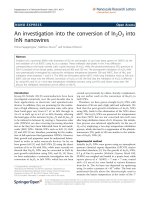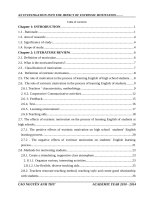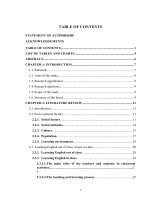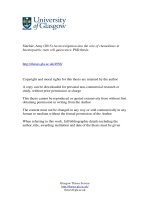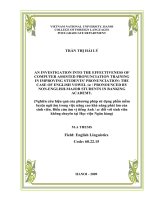An Investigation into the Influence of Using Listening Strategies on Listening Skills Development: An Example of Second Bachelor’s degree Students in English Department, Hanoi University
Bạn đang xem bản rút gọn của tài liệu. Xem và tải ngay bản đầy đủ của tài liệu tại đây (592.54 KB, 83 trang )
VIETNAM NATIONAL UNIVERSITY, HANOI
UNIVERSITY OF LANGUAGES AND INTERNATIONAL STUDIES
FACULTY OF POST - GRADUATE STUDIES
*************************
VŨ QUỲNH ANH
AN INVESTIGATION INTO THE INFLUENCE OF USING LISTENING
STRATEGIES ON LISTENING SKILLS DEVELOPMENT: AN EXAMPLE
OF SECOND BACHELOR’S DEGREE STUDENTS IN ENGLISH
DEPARTMENT, HANOI UNIVERSITY
NGHIÊN CỨU VỀ SỰ ẢNH HƯỞNG CỦA ỨNG DỤNG CHIẾN LƯỢC
NGHE TRONG KỸ NĂNG NGHE TRONG VIỆC PHÁT TRIỂN KĨ NĂNG
NGHE CỦA SINH VIÊN VĂN BẰNG HAI KHOA TIẾNG ANH TẠI
TRƯỜNG ĐẠI HỌC HÀ NỘI
M.A MINOR PROGRAMME THESIS
Field: ENGLISH TEACHING METHODOLOGY
Code: 60 14 0111
HA NOI - 2015
VIETNAM NATIONAL UNIVERSITY, HANOI
UNIVERSITY OF LANGUAGES AND INTERNATIONAL STUDIES
FACULTY OF POST - GRADUATE STUDIES
*************************
VŨ QUỲNH ANH
AN INVESTIGATION INTO THE INFLUENCE OF USING LISTENING
STRATEGIES ON LISTENING SKILLS DEVELOPMENT: AN EXAMPLE
OF SECOND BACHELOR’S DEGREE STUDENTS IN ENGLISH
DEPARTMENT, HANOI UNIVERSITY
NGHIÊN CỨU VỀ SỰ ẢNH HƯỞNG CỦA ỨNG DỤNG CHIẾN LƯỢC
NGHE TRONG KỸ NĂNG NGHE TRONG VIỆC PHÁT TRIỂN KĨ NĂNG
NGHE CỦA SINH VIÊN VĂN BẰNG HAI KHOA TIẾNG ANH TẠI
TRƯỜNG ĐẠI HỌC HÀ NỘI
M.A MINOR PROGRAMME THESIS
Field: ENGLISH TEACHING METHODOLOGY
Code: 60 14 0111
Supervisor: DR.NGUYỄN THỊ MINH TÂM
HA NOI - 2015
DECLARATIONS
I, Vũ Quỳnh Anh, hereby certify that the thesis entitled “An Investigation into the
Influence of Using Listening Strategies on Listening Skills Development: An
Example of Second Bachelor’s degree Students in English Department, Hanoi
University ” is the result of my own research in the fulfillment of the requirement for
the Degree of Master of Arts at Faculty of Post Graduate Studies — University of
Languages and International Studies, VNU, Hanoi and this thesis has not been
submitted for any degree at any other university or institution.
Vũ Quỳnh Anh
Hanoi, September 2015
i
ACKNOWLEDGEMENTS
First and foremost, I would like to express my special gratitude to my supervisor Dr.
Nguyen Thi Minh Tam for her valuable advice and insightful guidance at every stage
of the completion of this thesis.
I am also grateful to my lecturers at the Department of Post-Graduate StudiesUniversity of Foreign Languages and International Studies-National University, Hanoi
for their useful and interesting lectures which laid the foundation for this thesis.
Last but not least, my special thanks also go to second bachelor’s degree students at
7VB13, Hanoi University who participated in this study. Without them, this research
would not have been possible.
ii
ABSTRACT
In the past, listening was viewed as passive process which could come along naturally
without assistance. In fact, listening is active process which involves a variety of
mental processes. This study was designed to investigate the influence of using
listening strategies on students’ listening skills development. The participants in the
study were 24 first year students who were attending the second bachelor’s degree
course at Hanoi University. The participants went through an eight-week listening
strategy instruction section in metacognition which focused on planning, monitoring,
evaluating. From data collected through Metacognitive Awareness Listening
Questionnaire (MALQ), pre-test and post test, semi-structured interview, the study
yielded results indicating that the work carried out had an impact.
iii
LIST OF FIGURES AND TABLES
Page
Figure 1: Cycle of Action Research
14
Figure 2: The model of action research proposed by Kemmis &
15
McTaggart
Table 1: Records of students’ score in the previous final test
21
Table 2: Explicit Listening Strategy Instruction Sections
23
Table 3: Planning and evaluation strategies
27
Table 4: Directed attention strategies
28
Table 5: Person knowledge
29
Table 6: Mental Translation
30
Table 7: Problem Solving
31
Table 8: A detailed lesson plan of a listening strategy instruction
31
section
Table 9: Comparison of the means and standard deviation between
35
pre-test and post-test
Table 10: The results of paired sample t-test for pre-and post-test
iv
36
TABLE OF CONTENTS
Page
Declarations……………………………………………………………………………….............i
Acknowledgements ................................................................................................ ............ii
Abstract ................................................................................................................. ...........iii
List of charts .......................................................................................................... ............iv
Table of contents ................................................................................................... .............v
Abbreviations ........................................................................................................ ..........vii
PART A: INTRODUCTION
1. Background to the study and statement of problem.......................................... ………1
1.1.Theoreticalbackground………………………………………………………..........1
1.2.Statement of problem………………………………………………………….........2
2. Aim of the study…………………………………………………………………….....3
3. Research question………………………………………………………………..........3
4. Scope of the study …………………………………………………………….............3
5. Significance of the study ……………………………………………………….......... 3
6. Organization of the study ………………………………………………………….....4
PART B: DEVELOPMENT
CHAPTER ONE: LITERATURE REVIEW
1.1. Models of Listening comprehension………………………………………...............5
1.2. Listening Comprehension Strategies………………………………………………..7
1.2.1. Classification of Listening Strategies……………………………….................8
1.2.2. Listening Strategies used in the study…………………………………………9
1.3. Framework for Strategy Instruction………………………………………………....9
1.4. Empirical studies on the use of Listening Strategies………………………………10
v
CHAPTER TWO: METHODOLOGY
2.1 Rationale for the use of Action research ......................................................... …….13
2.1.1. The Action Research Process……………………………………………............14
2.2. Context of the study……………………………………………………………......16
2.3. Material………………………………………………………………………….....17
2.4. Subjects…………………………………………………………………………….17
2.5. Research instruments……………………………………………………………....18
2.5.1. Questionnaire ……………………………………………………………...........18
2.5.2. Pre-test and post-test……………………………………………………….........18
2.5.3. Semi-structured interview…………………………………………………..........19
2.6. Research procedures…………………………………………………………….....20
2.6.1. PHASE 1: Pre-action………………………………………………………….....20
2.6.1.1. The findings from the questionnaire …………………………………………..21
2.6.2. PHASE 2: Action……………………………………………………….…….....28
2.6.3. PHASE 3: Post-action……………………………………………………............33
2.7. Data Analysis …………………………………………………………………..….34
CHAPTER THREE: FINDINGS AND DISCUSSION
3.1. The findings of the pre-test and post-test…………………………………………35
3.2. The findings from the semi-structured interview………………………………….37
3.3.Discussion………………………………………………………………………......39
PART C: CONCLUSION
1. Recapitulation………………………………………………………………………42
2. Pedagogical implications …………………………………………………………...42
3. Limitations of the study ………………………………………………………….....43
4. Suggestion for further studies…………………………………………………….....44
vi
REFERENCES……………………………………………………………………………...45
APPENDIXES……………………………………………………………………………….I
ABBREVIATIONS
L2:
Second Language
SLA:
Second Language Acquisition
EFL:
English as a Foreign Language
IELTS:
The International English Language Testing System
Hanu:
Hanoi University
CALLA:
Cognitive Academic Language Learning Approach
MALQ:
Metacognitive Awareness Listening Questionnaire
vii
PART A: INTRODUCTION
1. Background to the study and statement of problem
1.1. Theoretical background
In the past, listening was considered as a passive activity and merit little classroom
attention (Thompson & Rubin, 1996; Vandergrift, 2004). Second language (hereafter
referred to as L2) researchers considered listening as an ability that could be
developed without assistance, and the language learning research reveals the lack of
attention to the skill of listening (Moyer, 2006; Mendelsohn, 1998). However, a
large proportion of the L2 research findings indicate that "listening is an important
skill through which language learners internalize linguistic information without
which they cannot produce language" and it is the first step in the process of
language communication (Brown, 2001, p.248). Listening is also now regarded as
one of fundamental language skills in EFL classrooms and gains more attention in
SLA research. Developing listening skill becomes a significant goal in many
language teaching courses. However, listening has always been perceived to be the
most challenging skill which commonly causes anxiety and frustration among L2
learners.
Listening is now viewed as an active and conscious process, in which listeners
engage in a variety of mental processes in an effort to comprehend information from
oral texts. They draw their attentions to the important information from the aural
input, comprehend the meaning of the input, and relate them to the contextual
information and background knowledge to produce output (O‘Malley, Chamot &
Küpper, 1989). As stated by Byrnes (1984, p.318), listening is a “highly complex
problem-solving activity”. However, a perfect match between input and knowledge
hardly could exist. As a result, comprehension gaps occur and special efforts to
1
acquire the meaning of oral message are required, especially for second language
learners. The mental processes that are activated by listeners to understand and
retain new information from oral input are referred to as listening comprehension
strategies. Since listening is a complex process in which learners decode and
construct the meaning of the received information by drawing on their prior
background knowledge as well as their linguistic knowledge, there seems to be
many difficulties that learners face during their listening process.
1.2. Statement of problem
In English language institutes in Vietnam, the process of listening skill has received
only slight emphasis despite a wide access to listening materials with accompanying
audiovisual technology in the classroom such as CDs or videos. The inadequate
competence or the linguistic difficulty of stimulus texts may prevent students from
improving their listening skills. Besides, it is somehow obvious that listening
strategies are missing in most of language teaching program, in which most
language learner complain about not being able to listen effectively and
appropriately. As listening comprehension has emerged as an important and distinct
foreign language skill (Byrnes, 1984; Dunkel, 1991), it is essential for teachers to
look for ways to facilitate improvement of learner in listening skills and make EFL
learners become more effective listeners not only to pass final exam with high
scores but also to perform well in real life communication. Having been teaching
listening skills for more than eight semesters, the researcher has had many
opportunities to observe students’ task-solving processes in listening practice tests.
In addition, the researcher has long been interested in issues related to the listening
skills. For these reasons, the researcher is motivated to explore to what extent
listening strategies have influence on students’ listening performance.
2
2. Aim of the study
The study aims to find out how listening strategies have impact on listening skills
development.
3. Research question
The present study is an attempt to recognize the role of using strategies in improving
listening comprehension and investigate the following questions:
To what extent does teacher’s explicit strategy instruction have effect on the
listening performance of the EFL students?
4. Scope of the study
The research was carried out on the first year second bachelor’s degree students in
English Department, Hanoi University. It would be challenging for this minor thesis to
cover all the aspects of listening. Therefore, the study only focuses on the influence of
using the strategies for exploiting listening tasks in section 1 and 2 of IELTS Listening
Practice Tests.
5. Significance of the study
By bringing out the result of the influence of using listening strategies on listening
skills development: An example of second bachelor’s degree students in English
department, Hanoi University and some given suggestions, the study hopefully will
somehow make the following contributions. First, the finding of the study may be
served as reference to EFL teachers to gear their teaching towards a more effective
approach to the teaching of listening. Second, the dissemination of findings could help
me and my colleagues to improve our own teaching at Hanu, as well as those who are
3
teaching English listening skills to second bachelor’s degree students at other
universities and colleges in Vietnam with the same situation as at Hanu.
6. Organization of the study
The study is organized into three parts as follows:
Part one: Introduction: presents background to the study, statement of problem, the
scope of the study, the method as well as the organization of the thesis.
Part two: Development: consists of three chapters
Chapter 1 discusses the literature review which is relevant to the research topic
including the models of listening comprehension, listening comprehension strategies,
empirical studies on the use of listening strategies.
Chapter 2 presents the research methodology of the study, which focuses on the
context of the study, the participants, the instruments, data collection procedure,
analytical framework, and data analysis.
Chapter 3 provides major findings and suggestions.
Part three: Conclusion: summarizes the findings of the study, presents implications
and limitations for the study as well as some suggestions for future studies.
4
PART B: DEVELOPMENT
CHAPTER ONE: LITERATURE REVIEW
This chapter discusses the theory and research into the areas which form the
underpinnings for the present study. The first section provides various models of
listening comprehension. The second section presents the strategies for listening. The
third section provides framework for strategy instruction and the chapter concludes
with a discussion of empirical studies on the use of listening strategies.
1.1. Models of listening comprehension
Cognitive psychology, the most developed model in accounting for comprehension
processes, has proved us with a better understanding of listening comprehension
process. According to the cognitive comprehension theory, schemata are the guiding
structure in the comprehension process. Schemata are described as “a data structure for
representing the generic concepts stored in memory. It can be used to represent our
knowledge about all concepts: those underlying objects, situations, events, sequences
of events, actions and sequences of actions” (Rumelhart, 1980, p.34). In other words,
the listener’s background knowledge, data structure of general ideas stored in memory
and the previously acquired knowledge structures are called schemata. Besides,
schemata are constantly being created and updated, providing the reader or listener
with new outlooks and new bases for interpreting texts (Rost, 2005). Schema (plural
schemata) means an abstract textual structure that the listener uses to make sense of the
given text. In terms of listening, schema refers to a mental structure consisting of
relevant individual knowledge, memory, and experience, which allows us to
incorporate what we hear into what we know (Anderson & Lynch, 1988, p. 139). The
listener makes use of linguistic and situational cues and also the expectations he/she
5
has about the new input to evoke schemata. When a schema has been evoked, it will
become a guiding structure in comprehension. If the incoming information is matched
with the schema, then the listeners have succeeded in comprehending the text; if they
are not compatible, either the information or the schema will be discarded or modified.
The principle of schema leads to two fundamental modes of information processing:
bottom-up processing and top-down processing. These two processings intersect to
develop an interactive processing. Thus, models for listening process include three
types which will be discussed as follows.
Bottom-up processing refers to using the incoming input as the basis for understanding
the message (Richards, 2008). Comprehension is viewed as a process of decoding
messages proceeding from phonemes to words, to phrases and clauses and other
grammatical elements, to sentences until meaning is derived. The listener’s lexical and
grammatical competence in a language provides the basis for bottom-up
processing. The listener makes use of “his knowledge of words, syntax and grammar to
work on form” in bottom-up processing (Rubin, 1994, p.210).In terms of listening, the
input is scanned for familiar words, and grammatical knowledge is used to work out
the relationship between elements of sentences. Thus, listeners use bottom-up
processes when they use linguistic knowledge to understand the meaning of a
message.
Whereas bottom-up processing goes from language to meaning, top-down processing
goes from meaning to language. In top-down processing, comprehension is viewed as a
process of activating the listener's background information and schemata to understand
what he/she hears. In top-down processing, the learner depends upon background
knowledge and expectations of what will follow next in the discourse and then infers
what the intentions of the speaker may have been. “Through top-down processing,
6
readers and listeners utilize real-world knowledge and refer to various types of
schemata that help them predict what will follow in the discourse” (Jung, 2003, p.
563). Significantly, beginner listeners who have less linguistic knowledge will depend
on their ability to make use of all the available resources to interpret what they hear by
top-down processes.
The interactive processing is the combination of bottom-up and top-down processing in
which listeners use both prior knowledge and linguistic knowledge in understanding
messages. In interactive processing, complex and simultaneous processing of prior
knowledge information, contextual information and linguistic information make
comprehension and interpretation become easy. According to Rumelhart (1982),
language is processed simultaneously and at different level in which phonological,
syntactic, semantic and pragmatic information interact with each other.
1.2. Listening Comprehension Strategies
One of the methods learners use to make sense of the incoming messages is making use
of strategies. Listening strategies which are used by language learners are relatively the
same as general learning strategies as it applied commonly to four basic language skills
“language learning strategies are used by learners to complete speaking, reading,
vocabulary, listening or writing activities presented in language lessons” (Oxford,
1990, p.9). Oxford (1990,p.8) defines learning strategies as “specific actions taken by
the learner to make learning easier, faster, more enjoyable, more self-directed, more
effective, and more transferable to new situation”. Many researchers have defined and
categorized many models of listening strategies. The following of the section is a brief
description of some of the major listening comprehension as well as the listening
strategies which were used in the coding scheme in the study.
7
1.2.1. Classification of Listening Strategies
With respect to listening strategies, Vandergrift (1999) implied that strategy
development is important for listening training because the use of strategies can lead to
better listening performance. Vandergrift (1997) proposed taxonomy of three main
types of strategies which includes metacognitive, cognitive and social-affective
strategies. This taxonomy is based on O’Malley and Chamot’s (1990) taxonomy of
learning strategies in order to make them more appropriate for listening strategies.
Cognitive strategies involve mental activities for manipulating the language to
accomplish a task. Cognitive strategies “operate directly on incoming information,
manipulating it in ways that enhance learning” (O’Malley and Chamot, 1990, p. 44).
For instance, listeners try to guess the meaning of new word by relying on contextual
or linguistic clues. Cognitive strategies consist of inferencing, elaboration, imaginary,
summarization, translation, transfer, repetition, resourcing, grouping, note-taking,
deduction/induction, and substitution.
Metacognitive strategies are mental activities that direct learners in their learning
process. According to O’Malley and Chamot (1990, p. 44), metacognitive strategies
“are higher order executive skills that may entail planning for, monitoring, or
evaluating the success of a learning activity”. In other words, they are strategies about
learning rather than learning strategies themselves. An example of metacognitive
strategies is listeners try to focus on the main topic and the keywords while ignoring
distracters like noise and other people around. Metacognitive strategies include
planning, monitoring, evaluating.
Finally, socio-affective strategies refer to activities that involve interaction with other
individuals or affective control in language learning. Common examples of socio8
affective strategies include working with others to solve one’s listening problems and
learning to relax when feeling afraid of not understanding others. Socio-affective
strategies include questioning for clarification, cooperation, lowering anxiety and selfencouragement, taking emotional temperature.
1.2.2. Listening Strategies used in the study
Since this study focuses on the influence of listening strategy use on students’ listening
skills development when students take the IELTS listening practice tests, the social/
affective strategies which involve questioning for clarification, cooperation and taking
emotional temperature cannot applied in IELTS listening practice tests. In addition,
when taking the Ielts listening practice tests, students do not employ cognitive
strategies such as taking notes or making summaries of important information;
cognitive strategies were also not included. Therefore, only metacognitive strategies
were applicable in this study.
1.3. Framework for Strategy Instruction
Many studies of the effectiveness of strategy training indicate that instruction in
learning strategies can help students enhance their learning ability and confidence
(Rost & Ross, 1991, Thompson & Rubin, 1993). Some researchers proposed models of
strategy instruction which were made up of several steps (Oxford et al.1990, O’Malley
& Chamot, 1990).
One of effective frameworks for explicit learning strategy instruction is Oxford’s
model of eight steps (Oxford, 1990), which includes the following steps:
Step 1: Determine the learners’ needs and the time available.
Step 2: Select strategies well.
9
Step 3: Consider integration of strategy training.
Step 4: Consider motivational issues.
Step 5: Prepare materials and activities.
Step 6: Conduct completely informed training.
Step 7: Evaluate the strategy training.
Step 8: Revise the strategy training.
Above all, the framework which is particularly appropriate to be used in designing
strategy instruction in this study is the one presented by Chamot & O'Malley (1994)
called Cognitive Academic Language Learning Approach (CALLA). The framework
consists of five steps as follows:
Step 1: Preparation (in this step, teacher elicits students’ previous knowledge
about and use of learning strategies)
Step 2: Presentation (teacher presents new strategies)
Step 3: Practice (teacher gives active applications of new strategies to language
learning tasks)
Step 4: Evaluation (students are asked to give self-evaluation of the strategies
which they have practiced)
Step 5: Expansion ( students are encouraged to use strategies taught to new tasks
and contexts)
1.4. Empirical studies on the use of Listening strategies
Until recently, most of the listening strategy studies have been focused their attention
on exploring the types of strategies used by learners during listening (Chang and Read,
2006; Cross, 2009; Elkhafaifi, 2005; Graham and Macaro, 2008; Hassan, 2000) or the
differences between strategy uses in successful language learner as compared to less
10
successful learners. However, there has been a growing interest for ways to teach
effective strategy use. There is a disagreement among researchers on whether listening
strategies should be actively taught or not. According to Chamot (2004, p.19) “teachers
should opt for explicit instruction and should probably integrate the instruction into
their regular course work, rather than providing a separate learning strategies course”.
Although there is not a consensus in the field of listening strategy instruction, research
show that listening strategies have beneficial effect on L2 learners as they approach
listening tasks. Mendelsohn (1995) argued that it is imperative for the teachers to teach
students to use strategies rather than simply provide opportunities for students to listen
to oral passages.
In the study of the influence of listening strategies listening strategy training on
Japanese EFL learners’ listening competence, Nakata (1999) found that the effect of
listening strategy training was more discernible on perception than on comprehension,
especially for those students who received low scores on the G-TELP.
Carrier (2003) conducted an explicit listening strategy study with a group of the
American high school ESL students that involved academic listening tasks instruction
for six weeks. The study showed that after receiving 15 listening strategy training
sessions, students showed a significant improvement in discrete and video listening
ability, as well as note-taking ability.
Moradi (2013) conducted a case study of the impact of listening strategy instruction on
a group of Iranian EFL learners’ listening comprehension of academic lectures. The
result revealed that listening strategy instruction had statistically meaningful effect on
EFL learner.
11
Having reviewed the related research literature, it appears that further study of listening
improvement through using listening strategies may be useful. In addition, listening
strategy is a new field which has recently gained more researchers' attention.
However, few studies have been conducted to explore the influence of using listening
strategies on listening skills development in Vietnamese context. Therefore, the present
study sought to explore the role of listening strategies in improving listening
comprehension.
12
CHAPTER 2: METHODOLOGY
The purpose of the chapter is to present the specific plan of procedure of the study. The
chapter begins with the rationale of the use of action research, the context of the study,
and followed by participants of the study, research instruments, methods of data
collection and data analysis respectively.
2.1. Rationale for the use of Action research
Action research is described as “a small scale investigation by teachers on specific
classroom problems for the purpose of curriculum renewal and/or professional
development” (Field, 1997; LoCastro, 1994; Markee, 1996, Nunan, 1993 cited in
Griffee (2012, p.109)). According to Bassey (1998, p. 93), action research is “an
enquiry which is carried out in order to understand, to evaluate and then to change, in
order to improve educational practice”. That is, action research is designed and
conducted by teachers with the aim of improving their own teaching. One significant
feature of action research is context-specific (McDonough & McDonough, 1997). In
other words, an action research is usually carried out in a specific classroom by a
particular teacher in order to bring about a change in their teaching and learning issues.
As a teacher, I am aware that every teaching situation is unique regarding content,
student level, student skills and learning styles and many other factors. Therefore, in
order to enhance student learning, a teacher must discover what work best in her
particular situation. When considering a proper methodology for this thesis, the
research as a teacher found that an action research is the most appropriate method as a
way of improving students’ listening skills.
13
2.1.1. The Action Research Process
There is no consensus on the number of stages involved in an action research. While a
researcher lists eleven stages (Burn, 2005), other researcher only lists six or seven
stages. Most of the action research models were influenced by the work of Kurt Lewin
who in 1940s proposed a four-stage action cycle: planning, acting, observing and
reflecting.
Figure 1: Cycle of Action Research. Adapted from Richards & Lockhart (1998, p.12).
The other model of action research suggested by Kemmis & McTaggart (2000, p. 564)
gives a deeper understanding of the cyclical processes involved in action research.
14
Figure 2: The model of action research proposed by Kemmis & McTaggart (2000, p.
564)
The theoretical framework for the design of the thesis followed the model of action
research proposed by Nunan (1992). This is one of many action research procedures
described by many researchers. However, the reason why I chose it is the simplicity of
the way it is presented by the author as well as its appropriateness regarding the context
of the study. According to Nunan, a cycle of action research consists of the following
steps:
● Step1: Initiation
● Step 2: Preliminary investigation
● Step 3: Hypotheses
● Step 4: Intervention
15
● Step 5: Evaluation
● Step 6: Dissemination
● Step 7: Follow-up
As described by Nunan (1992), an action research starts with a problem to be solved
and then followed by preliminary investigation in which teachers collect baseline date
to gain a deeper understanding of the nature of the problem. In the light of these initial
data, a hypothesis is formed. The intervention stage takes place after the hypothesis.
During the intervention stage, teachers devise and implement a number of strategies in
their teaching. Evaluation is done for the purpose of evaluating the intervention stage.
The dissemination is a step in which the researcher reports the result. Follow-up stage
explores alternative solutions for the problem.
2.2. Context of the study
The study was conducted in English Department, Hanoi University which offers
courses on translation and interpretation training. The aim of the course is to provide
students with an educational opportunity to develop their English language and cultural
competencies, plus basic and essential communication skills, in order to communicate
more effectively in an international environment.
The academic year of a second bachelor’s degree course begins in Mid-August (except
for the first semester which starts in October) and finishes at the end of June. It consists
of two semesters, 15 to 19 weeks each. For the first four semesters, the course mostly
focuses on English language skills development for students to practice listening,
speaking, reading and writing English. The first semester of second bachelor’s degree
16



